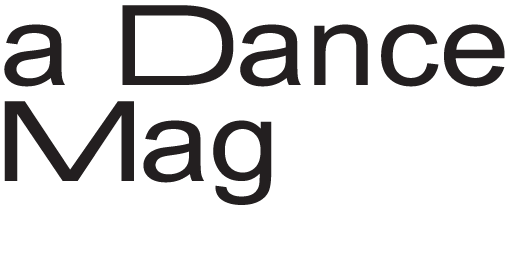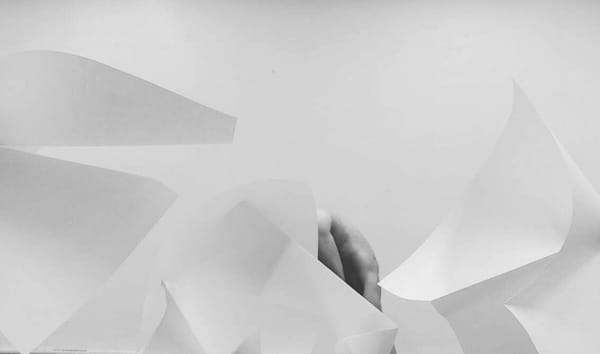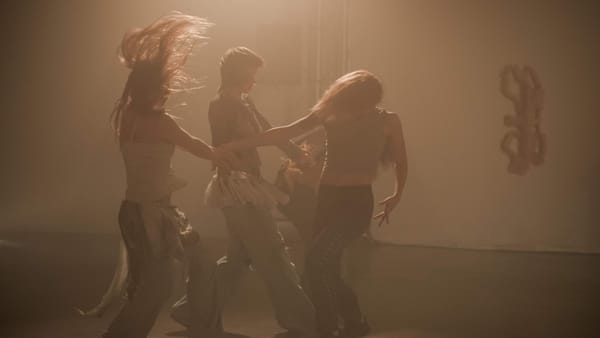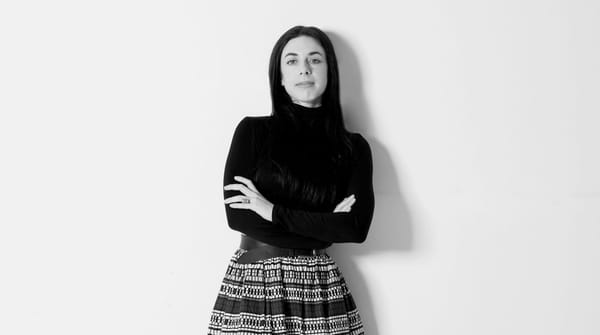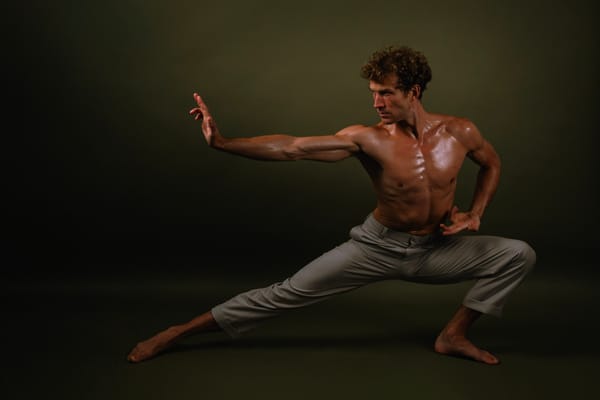A Guide to Becoming a Dancer in a Conservative Society
By Nerda Khara — In a country where dance is often misunderstood or discouraged, Nerda carves a path of quiet resistance—merging dance, ritual, research, and teaching to claim movement as a way of life in Pakistan.
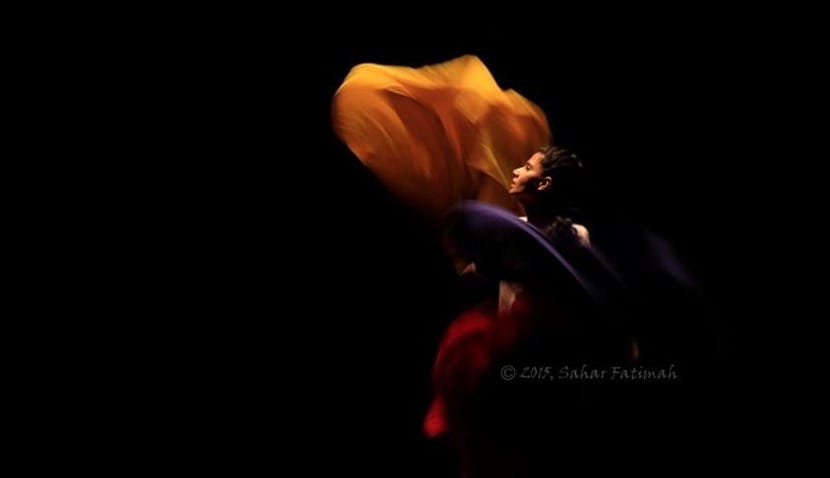
by Nerda Khara
With bright lights glaring in my eyes and thousands of eyes fixed on me, the music began to pulse through my ears as I stood on stage. I could barely make out the figures in the audience, just a sea of shadows stretching to the farthest corners of the auditorium. My heart pounded as the music swelled, and the moment arrived for me to hit my first beat. As I started moving, the audience faded away, their claps and cheers only faint echoes in the background. I was 19, and this was my first performance as a dancer.
The way I lost myself in movement during my performance was no different from rehearsals. In Pakistan, I was blessed and thrilled to be in a university where dance circle was not only running but also taken seriously. This was the start of my long journey in reaching where I am right now.
Giving a great performance brought a great feeling within me. However, with a sense of achievement came headaches, body pains, and little energy left to do anything else.
Embarking on a journey of dance in a society where cultural expectations and artistic passions often collide requires resilience, creativity, and a willingness to break barriers. This guide aims to share my experiences and the lessons I've learned, hoping to inspire others who may feel the same passion but face similar challenges. By sharing my experiences and practical tips, I hope to offer insight into the life of a dancer in Pakistan and inspire others to pursue their passions despite societal barriers. My hope is that this guide serves as a beacon of encouragement for those navigating the challenges of pursuing dance in a culturally restrictive environment, proving that with perseverance and dedication, one can transform obstacles into stepping stones towards a fulfilling artistic journey.
What I would gradually understand was that in a culture where dance can often be misunderstood or undervalued, especially for women, steering this path requires more than just talent—it demands courage, understanding, and a strategic approach to balancing personal passion with societal expectations. This is a journey filled with challenges and self-discovery. My commitment to dance often clashed with societal norms and expectations, leading to misunderstandings and criticism from those around me. In the conservative landscape of Pakistan, dance is often perceived through a narrow lens, and the relationship between a dancer and society can be fraught with tension. Despite the appreciation for my talent, there was an underlying expectation for me as a female to prioritize traditional duties over my passion for dance. This dichotomy forced me to ration my energy, reserving some for my artistic pursuits while fulfilling my other obligations.
If you find yourself in a similar position, eager to dance but unsure of how to wade through cultural boundaries, remember this: your passion is your compass, and with determination and the right strategies, you can carve your own path in the world of dance.
LESSON ONE – Discovering Cultural and Educational Barriers and still Embracing Dance Within
As a little girl, I exhibited a high level of physical activity. I loved playing outdoors, coloring and creating things. When came the time of getting enrolled in a school, my parents chose to go for gender-mixed private school system in Lahore, the city my family resided. However, during middle school, I transitioned to an all-girls school.
Due to the small size of the school, there were no events such as drama performances, or annual dance or music performances. Nevertheless, our school hosted annual sports days, where I regularly participated in various sports activities. Sports day included a small aerobic dance routine, which was framed as an exercise rather than a dance performance. Selected students were trained to perform this routine, which was minimalistic in nature.
In the sixth grade, I was chosen to be part of this group and subsequently selected as the lead performer after an audition process. I was also assigned the responsibility of choreographing the performance and teaching the routine to other students. This decision was made for two primary reasons: the school did not employ a dance instructor, and the other teachers lacked the experience to choreograph even a basic routine. Additionally, my ability to catch the beat and confidence in dancing, cultivated through practice at family events, further short-listed me for this role. Although I had to withdraw from the routine due to the cost of the costume, which wasn’t necessarily very high but still unaffordable for my family, I gained valuable insights about myself. The costumes were to be custom-made and the entire attire was meant to be worn just once, so my family felt it would be a waste of money. Despite my deep disappointment, I discovered that I possessed a natural ability to move my body, I had an innate sense of rhythm, and my body demonstrated greater flexibility. Additionally, I learned that I could innovate new movements using the foundational dance vocabulary I already knew.
Later on, the only chances I had to dance were at weddings, as my family valued dancing and singing, unlike some that didn’t. I thoroughly enjoyed the practice sessions preceding each event. Wedding dances in big cities such as Lahore, Islamabad and Karachi typically featured Bollywood-inspired routines, contemporary folk dances like Bhangra and Luddi, and occasionally incorporated a touch of hip-hop alongside these traditional forms. Although I was not exceptionally extraordinary, as my cousins and siblings were equally proficient dancers, I still managed to stand out due to my ability to quickly memorize the choreography.
For my intermediate studies, I chose fine arts as my major, finding mathematics and science overwhelmingly difficult. My affinity for painting made fine arts a natural choice, allowing me to express my emotions freely. Alongside fine arts, my other subjects included physical education and civics. My active lifestyle contributed to my highest scores in physical education, particularly in the practical exam that encompassed learning the rules, fouls, and services of badminton, tennis, and table tennis, as well as javelin and ball throws. Learning activities such as cartwheel, somersault and headstand were also part of the course. Additionally, understanding the postures and movements for each sport contributed to my strong performance in the theoretical component.
Once again, attending an all-girls college, I had the opportunity to participate in the sports day dance routine, which was a Punjabi folk dance this time and once again despite being a proficient performer, I had to withdraw due to the costume costs. Unlike before, I was not disappointed as I had fine arts as a medium to live my passion for art, and the thought of performing in the scorching heat was unappealing.
To all the young readers of this guide, remember: every challenge and every setback is an opportunity to discover more about who you are and what you can become. As you embark on your own journeys, be open to learning from every experience, even those that seem to limit you.
LESSON TWO - From Hobby to Passion: Orchestrating Dance in Pakistani Academia
Understanding the importance of balancing passion with practicality is crucial in any journey.
Upon graduating from high school, I dedicated myself to gaining admission to the National College of Arts (NCA) in Lahore, the premier arts institution in the city. My hard work paid off, and I successfully enrolled at NCA. During this period, I was entirely focused on painting, and I, like any other Pakistani, ignored dance in education. For me it was just a phase of life or a hobby, which was again a big thing, as not many girls would say dance is even their hobby in Pakistan. Later reflecting on this shift, I realized that dance is not widely accepted in Pakistan as a respectable pursuit.
Until I was enrolled at the university, my exposure to dance was initially limited to Indian reality shows and Bollywood films, leaving me largely unaware of the global dance scene. Although Pakistan and India share many folk and classical dances due to their historical and cultural ties, Pakistan’s complex history has fostered a more ambivalent attitude towards dance. Consequently, dance in Pakistan is often treated with silence, as if to avoid confrontation or express disapproval. My generation was accustomed to this muted approach to theatrical art forms, especially dance. So, I accepted that India was more culturally expressive and inclusive of diverse art forms, including dance.
At the start of my four-year undergraduate program, I discovered the dance circle at my university, known as the NCA Dance Society. In Pakistan, art universities often offer after-school activities where students gather to pursue their interests. As a creative space, NCA allowed students the freedom to experiment with various hobbies, making it one of the few universities in Pakistan where students took the initiative to introduce dance. This initiative was also partly due to dance being seen as a symbol of liberty and open-mindedness, often associated with the elite. By the end of my first year, I joined the NCA Dance Society. Initially, I felt a bit shy because the society included members of both genders. Although I had danced with my cousins and brothers at weddings, this situation was different as it required getting comfortable dancing with unrelated men. It took some time for me to adjust.
Traditionally, the senior-most and best-performing member would be the director regardless of their gender, supported by senior performers and newcomers like myself. No formal training took place; we had to refine our performances independently. Performers rehearsed after school for four to five hours and worked on their movements. The director would select a theme or storyline for the performance, and everyone would collaborate on choreographing different pieces. I was always excited for my part and would rehearse with a lot of energy. Newcomers were typically given smaller roles, as it took time for them to open up and overcome their hesitation. However, in my case, I was given significant stage time in my first performance, including a part with the director himself. This experience was pivotal in my career, not only because it marked my first performance as a dancer but also because it was when I gained the confidence to explore various dance genres and collaborate with male dancers in a supportive environment.
From this first performance, I learned the importance of perseverance and embracing vulnerability on stage. It taught me that to truly connect with dance, one must let go of fear and focus entirely on the movement.
I continued with NCA Dance Society for the next three years, which meant performing in the same auditorium five more times. These performances included both group and solo acts. We explored a variety of genres, from street jazz to hip-hop, and from South Asian classical to contemporary. After my third performance, I was appointed the director of the society as I had reached my third year of undergrad. During my time as director, I created a performance that incorporated pieces of Bollywood dance. The biggest challenge for me in creating this performance wasn't the choreography or learning new steps—it was working with a team and getting them to follow my direction. Since all the performers were adults, they didn't think I was capable of correcting their steps or postures. They would miss rehearsals, arrive late, and generally disregard my instructions, which frustrated me. I could envision how the movements should look if done correctly, but some of the performers refused to follow my guidance. Preparing the group dance was incredibly difficult, but as the performance date approached, I somehow managed to assert myself and gain control over the team. Perhaps because I was the one responsible for the outcome, I found the determination to make everyone listen to me.
Our final performance went on to win the Best Performance award. However, I chose not to direct the next festival because it was too challenging to work with people who didn't cooperate or trust my leadership. For that semester, I decided to focus on my painting assignments, as my teachers were unhappy with the amount of time I was dedicating to dance instead of my studies. My major in miniature painting required intense focus and long periods of sitting still, which was difficult for me. I only participated in the festival with a brief two-minute solo performance, which was placed between the larger dance society performances.
During this time, my life felt the most chaotic. I struggled to manage my time and energy, often swinging between investing too much in dance or stepping away from it entirely to focus on other things. In my final year of undergrad, I temporarily step back from dancing to concentrate fully on painting to ensure I graduated. After graduation, I decided to seek out dance communities outside of NCA. I hoped to eventually find a job where I could teach dance in a private school in Pakistan, as some of the elite private schools offered various extracurricular classes.
You might manage to balance passion with practicality. But this might not be enough. As you advance in your journey, you may find yourself Moving through conflicting interests, challenges and responsibilities. Embrace the process, learn from each experience, and accept all as a part of your unique path.
LESSON THREE - Integrating Passion with Professional Development: Journey to Europe
After graduating from university, I took a job as a fine arts teacher at a school, but I quickly realized I wasn't happy with the role. I stayed for three months before receiving an interview call for a position as a theatre teacher at Lahore Grammar School, one of the best schools in Pakistan. I accepted the job and worked as a production manager and drama teacher there for a year. During that time, I proposed the idea of starting a dance club at the school, which was successfully implemented. The success of the dance club then led to the creation of a dance curriculum that I introduced into the regular classes, working primarily with boys from the junior and middle schools. At the same time, I continued to pursue my passion for dance by performing in group pieces with a dance company called The Colony Lahore.
After teaching dance in this school for three years, I realized I wanted to deepen my understanding of dance. I had already attended several international dance and theatre workshops, which had broadened my perspective, but I was eager to find a more extensive learning experience that would focus on dance and help me develop my skills even further. I started applying for different international masters programs.
For many of you, your passion for dance might venture you into uncharted territories. Don’t be afraid to take risks or change your path if it leads you closer to what you love. Keep seeking opportunities to expand your knowledge and refine your skills. Every new experience adds depth to your practice and helps you discover new facets of dance.
During the early days of the pandemic, when most in-person activities were suspended and online dance classes were still a challenge, I found myself with unexpected free time. It was during this period that I received the news of my selection for a dance research master in Europe. It was a significant step for me, as going abroad for an extended period to study isn't an opportunity every girl in Pakistan gets. My family, being liberal, supported me, though they were still concerned about me leaving.
The program allowed me to delve into dance anthropology and ethnochoreology, which greatly enhanced my understanding of the cultural significance of dance. I also had the opportunity to learn dances from around the world. Besides, meeting international students from diverse cultural backgrounds was a particularly enriching part of the experience. These made me realize how music and dance is deeply rooted in the culture they emerge from.
For my dissertation, I chose a research field that allowed me to explore a meaningful question. Conducting research within Pakistan was an obvious choice for me, given the scarcity of studies on dance in the country. I selected the Kalash Valley as my field site, a remote area in northern Pakistan near the Afghan border. As a Muslim, I was deeply aware of the prevailing attitudes towards dance in Pakistan, which made me particularly curious about the relationship dynamics between the Kalasha people, who are non-Muslims, and the Muslim communities living in the region. This led me to formulate my research topic, which was “The Co-existence of Religions and Its Effect on Kalasha Dance.”
I traveled to the Kalash Valley during the celebration of their harvest festival, Uchaw. Given that dance is an integral part of Kalasha rituals, this festival provided an ideal opportunity for conducting ethnochoreological research. In the field, I faced challenges in building rapport with the Kalasha community—a common experience for many researchers. I noticed that the Kalasha people interacted with other researchers only minimally, treating them in an official capacity, much like how they would handle formal engagements. Similarly, most tourists were treated as visitors—received politely but kept at a distance and not fully welcomed into all aspects of Kalasha life. Initially, I was treated in the same manner—well-received but held at arm’s length. However, by the end of my stay, I had formed friendships with everyone in the village where I was staying. The key to this connection was my deep love for dance and my curiosity about their dance traditions. When the Kalasha people saw how passionate and engaged I was with their dance and music, they not only welcomed me into their dance practices but also invited me into their homes.
During my stay in the Kalash Valley, I had a unique experience that felt like a blend of two worlds. Here I was, living in Pakistan, yet dancing with complete freedom and joy. I would perform my five daily prayers and then join my fellow dancers for their night-time practices. Kalasha dances performed during Uchaw are of three distinct types, each paired with a specific musical accompaniment. The dances include the Ca’, D’hushak, and Drazhayl’ak, each with its unique structure. These dances are typically performed in groups of three or more, with each member holding onto others in their group. Traditionally, these groups are divided by gender, with women forming their own groups and men forming theirs. While mixed-gender groups can sometimes be seen, they are less common. I felt more at ease participating in these dances, particularly because I was dancing in a group with other women.
It was an emotional journey, filled with moments of introspection. At times, I questioned the seriousness of it all—what was the true purpose of dance for these people? It seemed so joyful, almost too much fun to be taken seriously. Although I may not have fully grasped the deeper meaning behind their dances, I did come to understand just how vital it was to their way of life. Dance was not just an expression of joy but an essential part of their cultural and spiritual identity.
Although, strictly speaking, I remained an outsider even after forming close bonds, however when I danced with them, I felt more in tune with the Kalasha people than with any Muslim observing from outside their dance circle. In those moments, the barriers seemed to fade, and I felt a sense of unity that transcended cultural differences. I kept all this experience in mind after going back from the field and writing my dissertation.
By this time, I had made it clear to everyone I knew back home, how deeply I love dance. I graduated in 2022 and returned to Pakistan, where I resumed my teaching career in 2023, bringing with me a wealth of knowledge and a renewed passion for dance education.
One profound lesson I've learned—and one I wish to impart to everyone practicing dance in culturally restrictive environments—is the importance of sharing your passion. Your experiences and knowledge can inspire those around you to see dance in a new light. Whether you choose to teach, perform, or simply continue learning, your dedication to dance will leave a lasting impact on your community.
Nerda Khara is a Pakistani artist, dance educator, and ethnochoreologist. With her passion for Pakistani folk dances, she pioneers introducing dance into Pakistani school curricula, focusing on choreographing with children to foster cultural appreciation.
